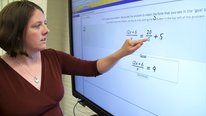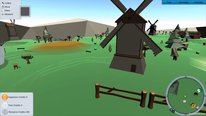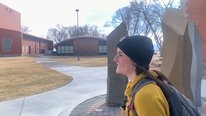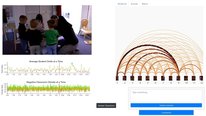- Ivon Arroyo
- https://www.umass.edu/education/people/ivon-arroyo
- Associate Professor
- Developing Computational Thinking through Game Design & Play
- http://wlcp.embodied.wpi.edu/
- University of Massachusetts Amherst, Worcester Polytechnic Institute
- Francisco Castro
- https://franciscastro.github.io/
- Researcher and PhD Candidate
- Developing Computational Thinking through Game Design & Play
- http://wlcp.embodied.wpi.edu/
- Worcester Polytechnic Institute
- Avery Harrison
- https://averyharrison.wixsite.com/experience
- Ph.D. Candidate
- Developing Computational Thinking through Game Design & Play
- http://wlcp.embodied.wpi.edu/
- Worcester Polytechnic Institute
- Erin Ottmar
- https://sites.google.com/site/erinottmar/
- Assistant Professor of Learning Sciences and Technology
- Developing Computational Thinking through Game Design & Play
- http://wlcp.embodied.wpi.edu/
- Worcester Polytechnic Institute
- Grace Seiche
- Undergraduate Student and Researcher
- Developing Computational Thinking through Game Design & Play
- http://wlcp.embodied.wpi.edu/
- Worcester Polytechnic Institute
- Hannah Smith
- Ph.D. Candidate
- Developing Computational Thinking through Game Design & Play
- http://wlcp.embodied.wpi.edu/
- Worcester Polytechnic Institute
Public Discussion
Continue the discussion of this presentation on the Multiplex. Go to Multiplex












Erin Ottmar
Assistant Professor of Learning Sciences and Technology
Hello everyone! In this video we present an overview of the Wearable Learning Cloud Project that have been supported through several NSF research and development awards over the last several years!
The goal of our projects are to develop new ways for students and teachers to engage with game design, creation, and collaborative game play math in classroom!
Please post your questions or comments below! We look forward to an exciting exchange this week!
Kristin Flaming
Sarah Stanlick
Stacy Shaw
I really love the idea of students taking ownership of the game-creating process. Do you think there is room in this area of work to encourage more peer-to-peer learning through games? Or maybe even having older students design games for concepts younger students are learning, and teach them?
James Brown
5/6 STEM Teacher
I love the idea of combining mathematics and gaming to develop computational skills in teachers and students. How have you recruited teachers who might be technology averse to bring this to their classroom?
Erin Ottmar
Assistant Professor of Learning Sciences and Technology
Thanks for your question! We conducted a 14-week professional development program with math teachers where we introduced them to the tool and the game play/creation model. Many of them were technology averse to begin. After playing the games, they then created the games with a group of other teachers and then used the tools. This got them past a lot of their challenges. They then implemented their games with the students in their own classroom. It was a fun process to watch and is a model that we think works well. If teachers experience the process for themselves, they are better prepared to implement it and support their students.
IVON ARROYO
James Brown
Robert Reardon
Your "game play and design framework" is quite thought-provoking--as is the concept of "wearable learning." I'm impressed by the evidence of effectiveness you have found.
Ivon Arroyo
Associate Professor
Thank you so much Robert!
Please stay in touch with our research at wearablelearning.org
We are still working on the website, but you can find publications and further information.
Thanks for visiting!
Stacey Forsyth
Director
I really enjoyed seeing the program in action in various classrooms - the students look so engaged! Can you share a bit more about the types of math games that they're creating and playing? I'm also interested to hear more about how you measure the development of their computational thinking skills.
Ivon Arroyo
Associate Professor
Dear Stacey,
Great question!
There are researcher-created games, teacher-created games, and student-created math games.
The best developed ones are researcher and teacher-created games. We have a set of 7-8 of these games for different areas of math, which are pretty well explained in our web site. We have empirical evidence of learning from pre to posttests for these games, in particular:
EstimateIT! (to promote measurement and estimation math skills)
Tangrams Race (Learning about classification of shapes according to their properties)
What's my Line? (learning about linear equations plotted on a coordinate plane)
Integer Hopscotch (learning about integers and operations over integers)
Running for Fractions (relay race of building equivalent fractions and adding them)
Each of these are further explained in our website: wearablelearning.org, in the "Playing Games" link:
https://wl.teachbound.com/#play
Also, we have analyzed the games students create themselves. We have a paper on that, accessible from our website also, called:
Harrison, A., Hulse, T., Manzo, D., Micciolo, M., Ottmar, E., & Arroyo, I. (June, 2018). Computational thinking through game creation in STEM classrooms. Proceedings (Part II) of the 19th International Conference on Artificial Intelligence in Education. London, U.K. pp. 134-138.
---
Regarding measuring computational thinking, this is the exact we are working on right now in our new award that is only 9 months old. So far, we have measured improvements in interpreting, modifying and creating finite-state-machines, which is what students code in the programming language (states, transitions between states).
Please stay in touch with our research at wearablelearning.org! We are still working on the website, but you can find publications and further information.
Thanks for visiting!
Jill Denner
I enjoyed your video and am glad to see how you have integrated game design into classrooms!
Catherine Haden
Really exciting work. Can you describe a bit how you are measuring engagement in the research component?
Ivon Arroyo
Associate Professor
Hi Catherine, we have measured ease of use of the WLCP during the game creation process. We have started measuring students attitudes towards math and computing also, more recently, based on instruments originally by Eccles & Wigfield.
Raffaella Borasi
This is a really a great way to introduce computational thinking with young children - and probably older children as well!
I'd love to see some examples of the games the students (and their teachers) created - do you have links to any of those products?
Ivon Arroyo
Associate Professor
Dear Raffaella, if you go to: wearablelearning.org, and you choose the PLAYING GAMES tab, you will see a list of games, instructions to play them, and materials required.
The instructions should be clear enough for you to log in from wearablelearning.org and play the games.
DeLene Hoffner
Program Coordinator
In your professional development, you meet the growing need of technology integration in the classroom to develop computational skills. What is the teacher feedback on their impressions of their students growth?
Ivon Arroyo
Associate Professor
We have received very positive feedback from teachers. The engagement part is so powerful, that it is a driver to have rich discussions with them about the material.
Sarah Stanlick
Your work is so important and engaging for students. I wonder if you are writing about/exploring that play aspect as it connects to breaking down math anxiety. The physicality of the games that you can see in the video made me wonder about that and the role of muscle memory (especially as they are using their motor skills to engage tactically with geometry). We know that physical exercise can be one way of managing anxiety, and math anxiety is a pervasive. I am sure you are thinking of that, but I would love to hear more!
CarlaDean Caldera
This is very exciting work! It is great to see the enthusiasm in the kids as they engage in project. Gaming... Are there other links to explore the creations of students/teachers?
Jeff Northrup
Fascinating! Love the project-based learning approach. My curiosity is mostly around the idea of introducing younger kids to "abstract concepts" at earlier ages. I think the rationale for waiting until later in their cognitive development is that abstract thought emerges later. But I love the idea of challenging that. Do you see a limit in how much the younger students can absorb or even comprehend? Does it vary by student? Does an older student comprehend better? Would love to hear about what you are experiencing there. Well done!
Hannah Smith
Ph.D. Candidate
Hi Jeff! We have had one teacher lead her 5th grade class in the game creation and programming process. This is the youngest group we have had working on the game creation side. These students did well, but it did vary by student as the teacher reported, "some kids were naturals at programming!" I think it may have more to do with prior experience with technology rather than age but it will be interesting to explore this further and push the age boundaries!
Tsivia Cohen
Really cool video. Love the idea of game creation--it's something children we've seen very young children do successfully at our museum. The wearable tools you've developed free children to move and interact while scaffolding their learning. Great to see this connection of digital and real world experience. Thank you for this innovative work.
Francisco Castro
Researcher and PhD Candidate
Thank you so much for your feedback, Tsivia! It's great to hear about similar efforts (and successes!) on game creation with learners. What kinds of games do the children at your museum create and in what contexts/domains are they creating them? We're interested to see and learn from other efforts and projects that explore game creation as a vehicle for learning!
Tsivia Cohen
We've facilitated workshops where children create board games, but we've also noticed that just about any activity that invites a way to measure success, keep score or has a goal can turn into a game. Another thing I really liked in your video is realizing that we don't need to create games for children; they can create them on their own.
W. Adrion
Ivon - now that you are moving (back) to UMass Amherst, we should talk about how to collaborate. Rick
Ivon Arroyo
Associate Professor
Hi Rick! Definitely! I was also thinking about you and connecting again, there is so much work we could do together.
Sunni Newton
This is a very interesting project. Your use of games and letting students create the games is a great idea and I'm sure very engaging for the students. I'm curious how you all are defining computational thinking, and whether/how you are measuring this as an outcome of the project. Thanks.
Avery Harrison
Ph.D. Candidate
Hi Sunni, thank you so much for your interest in our project! Defining and measuring computational thinking has been an ongoing conversation over the past few years, especially since it seems like there still isn't consensus in the field about defining and measuring CT. We have used pre- and post-assessments with items that are closely related to the programming aspects of the WLCP as well as broader open-response items, but we are still trying to refine the way that we measure computational thinking for this project. If you have any thoughts about measuring CT or would like to share any experiences of your own, we would love to discuss this more!
Sunni Newton
I agree, these issues of defining and measuring computational thinking are important and fascinating open questions within the field, and ones we are also working through in our computer science education research.
Jennifer Kidd
Great empowering project. How do you recruit the teachers to participate in your project? You mentioned some are tech-adverse at the start. Do they volunteer or are they "voluntold"?
Erin Ottmar
Assistant Professor of Learning Sciences and Technology
Thanks Jennifer! We recruited teachers by posting an announcement in our STEM Education Centers' newsletter. The teachers contacted us. We were able to get support from an NSF RET which provided support to the teachers to engage in our work after school. We conducted a 14 week PD on campus and at a middle school. It was all voluntary and got really great feedback. We also work with after school programs and clubs such as the YMCA, boys and girls clubs, and local high school and middle schools.
Jennifer Kidd
Sounds awesome! So the teachers were compensated for their effort? That always helps. Do you know Florence Sullivan at UMASS Amherst? I'm a fan of hers. She does good work in a similar vein.
Erin Ottmar
Assistant Professor of Learning Sciences and Technology
Yes- the teachers received quite a nice stipend for their 14 week efforts. Yes! Florence was an advisor on our EAGER grant that jump started this work and is a colleague of Ivon Arroyo at UMASS.
DeLene Hoffner
Program Coordinator
Thank you for your wonderful responses and insights in this dialogue.
I wondered what were your greatest challenges in the project.
Erin Ottmar
Assistant Professor of Learning Sciences and Technology
One of the biggest challenges has been with measurement.
Mitchell Nathan
This is such a great way to foster computational thinking through embodiment, collaboration and design of games. I think Seymour Papert would be proud to see this in use. Thanks for sharing this!
IVON ARROYO
Erin Ottmar
Assistant Professor of Learning Sciences and Technology
Thanks Mitch!!
Ivon Arroyo
Associate Professor
Thanks Mitch! Always happy to hear your comments, and I enjoyed your video so much also!
DeLene Hoffner
Program Coordinator
In playing the games, do you use any strategies to help them process what they are learning through the games? Do you discuss key concepts or skills they are developing?
Ivon Arroyo
Associate Professor
This is a great question DeLene. In the next phase of the project, we are developing tools for the teachers to see detailed summaries of students performance in the questions of the games, so as to have materials to have retrospective discussions with their students, given knowledge of which were the hardest and easiest questions.
Leanne Ketterlin Geller
Thanks for sharing information about your project. Engaging students in the game design process is a great idea. I wonder what measures you are using to assess students' computational thinking. It seems like there would be a number of other important educational and affective outcomes that could be impacted through game play. Are you also measuring other variables? Thanks again for sharing your work.
Erin Ottmar
Assistant Professor of Learning Sciences and Technology
We are currently creating measures to assess computational thinking. Much of this is based on work by Weintrop and colleagues but we are adapting these items to fit our context. We are asking students and teachers to report on usability and engagement and interest but hope to add additional outcome measures in the next stage of the project.
DeLene Hoffner
Program Coordinator
What is the most important thing that viewers are taking away from this project?
Ivon Arroyo
Associate Professor
Hi DeLene, I think the most important thing that viewers are taking away from this project is that it is feasible to play and create games with the Wearable Learning Cloud platform, and that the cycle that starts with teachers playing games and ends with students themselves playing and creating games works. In the process, both students and teachers exercise Computational Thinking, program, taking a variety of perspectives, and they also learn math in the process. In addition, the level of affective engagement of students and teachers is extremely high.
Michael I. Swart
Hello fellow EMIC developer! The learning cloud platform is a great update to the last time we got to see this work at PME-NA. So cool to see how it is moving forward. The video presents "statistically significant increases in CT". Is this measured in a pre/post within design or between design with a control comparison?
John Chikwem
I like this video because it helps students to design their own games. When students design a game, they are likely to improve upon it. That helps the learning process.
Krishna Kaipa
I agree with the presenters that bringing computational thinking learning to elementary students is a challenging task. The idea of staring with playing a game and then having the students to bootstrap from that experience and create their own games is a strong tool to enhancing students' computational thinking skills. Amazing work by the researchers of this work.